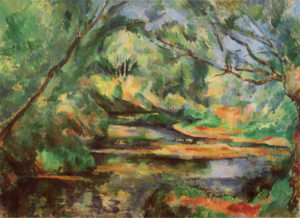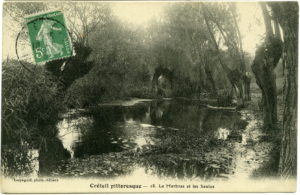R766 – Eau courante en sous-bois (Le Morbras à Créteil ?), 1892-1894 (FWN310)
Pavel Machotka
(Cliquer sur les images pour les agrandir)
A commonly asked question about painting is whether new subjects elicit new styles, or whether styles determine the subjects the painter will undertake. The answer may well be different for different painters, but for Cézanne, whose work is informed by coherent styles and at the same time responsive to each new site, the relationship must be reciprocal. But if the mutuality—the flexibility as well as the analytic vision—is a quality we admire, its results also make it difficult to date the paintings. With Eau courante en sous-bois, for example, one could argue that the style is from the end of the previous period, but one could equally well argue that it is the style most appropriate to the subject; on the first argument the date would be earlier, and on the second it would be later. (Perhaps it was for that reason that Rewald proposed a five-year bracket for it.)
With the date made uncertain, the proper focus becomes the relation of the style to its subject. Cézanne has obviously concentrated closely on integrating his composition entirely by the touch—which, given the meandering layout, must have been an exercise requiring considerable thought. Almost at no point does the touch describe the textures of the objects, except perhaps in the water, where it is horizontal (but that also gives the picture a needed base). Elsewhere, the touch needs to perform many other roles: to support the diagonal recession of the brook, to balance each of the branches, and to provide a certain measure and order in all this confusion. In the upper left quadrant, the touch slants up toward the corner and opposes the near branch; there, it supports the recession in space and keeps the corner from closing the scene[1]. Near the center, a different touch provides horizontal and vertical stability. But it all seems a lot of work, and I think that Cézanne must have felt intuitively that it was color that would cut through the effort asked of the viewer: the harmony is fresh and crisp and the play of light and shadow is incandescent.
Source: Machotka, Cézanne: The Eye and the Mind.
[1] The corner was initially left bare, and only later was filled in with an opaque touch (perhaps not by Cézanne’s hand). This interrupts the rhythms of the other touches and encloses the scene in a sealed space. Perhaps nothing demonstrates so clearly the difficulty Cézanne spoke of in bringing together his initially distinct patches; every touch, and every blank space, had consequences for the whole. Here the close space of the brook needed room to breathe.
Une carte postale ancienne semble représenter le site de ce tableau, particulièrement la rive droite :



